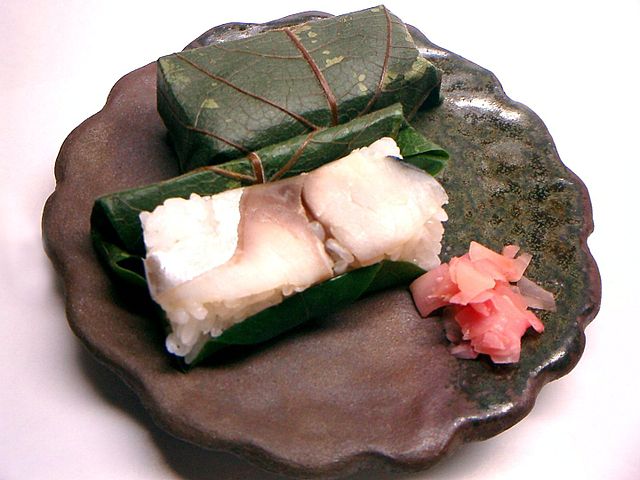There are many kinds of sushi, most of them with fish, a few with other things like avocado or eggs, and they come in a variety of forms: nigiri sushi (classic rice on bottom, fish on top), maki sushi rolls, temaki sushi wrapped in a piece of seaweed looking like an ice cream cone, chirashi sushi (rice in a bowl with raw fish sprinkled on top)… However, the one thing all sushi has in common is that it must be consumed fresh on the day it is made – it is raw fish, after all.
Well, there are exceptions to everything of course. In this case here, one of them is called kakinoha sushi, persimmon leaf sushi. It looks like a standard nigiri sushi wrapped in a green leaf, but there is a little more to it: To make kakinoha sushi, the cooked rice is placed in a wooden mold, the already cured fish is put on top of it, and the whole thing is pressed firmly. The finished pressed sushi is cut into bite sized pieces and only now individually wrapped in salted persimmon leaves. After that, the pieces are put back into the mold, topped with something heavy, and left to rest for a few days in a cool place.
 Eating kakinoha sushi is easy: Simply unwrap and eat with your fingers (like all sushi, by the way). The persimmon leaf (which is not eaten although one probably could) can be used as a sort of natural napkin to touch the sushi, which are a bit more sticky than usual. Their distinct taste originates from the persimmon leaves – which are antibacterial, by the way – but it is not strong enough to overpower the fish. Most often, salmon, mackerel, and trout are used in kakinoha sushi.
Eating kakinoha sushi is easy: Simply unwrap and eat with your fingers (like all sushi, by the way). The persimmon leaf (which is not eaten although one probably could) can be used as a sort of natural napkin to touch the sushi, which are a bit more sticky than usual. Their distinct taste originates from the persimmon leaves – which are antibacterial, by the way – but it is not strong enough to overpower the fish. Most often, salmon, mackerel, and trout are used in kakinoha sushi.
 This type of sushi is a speciality of Nara, a landlocked little city southeast of Kyoto; this is interesting because one would expect a fish product like this to be made where fresh fish is easy to get… The dish was traditionally prepared for ceremonies like the summer festival, where it is important to have food that does not spoil easily. Today, kakinoha sushi can be bought in many places all over Kansai at least, and it is a popular ekiben – the kind of bento food box you eat when traveling by Shinkansen. But that’s a story for another weekend…
This type of sushi is a speciality of Nara, a landlocked little city southeast of Kyoto; this is interesting because one would expect a fish product like this to be made where fresh fish is easy to get… The dish was traditionally prepared for ceremonies like the summer festival, where it is important to have food that does not spoil easily. Today, kakinoha sushi can be bought in many places all over Kansai at least, and it is a popular ekiben – the kind of bento food box you eat when traveling by Shinkansen. But that’s a story for another weekend…
